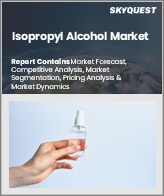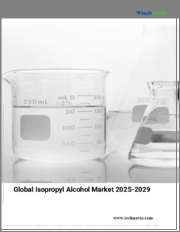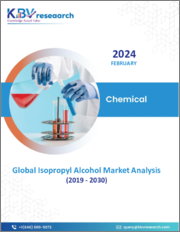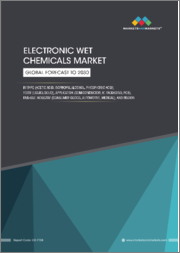
|
시장보고서
상품코드
1468298
이소프로필 알코올 시장 보고서 : 용도, 산업, 지역별(2024-2032년)Isopropyl Alcohol Market Report by Application, Industry, and Region 2024-2032 |
||||||
세계 이소프로필 알코올 시장 규모는 2023년 46억 달러에 달했습니다. 향후 IMARC Group은 2024-2032년 3.4%의 연평균 성장률(CAGR)을 보이며 2032년에는 63억 달러에 달할 것으로 예상하고 있습니다. 재생 가능하고 지속가능한 원료 조달에 대한 관심 증가, 개인 위생을 유지하고 감염을 예방하기 위한 손 소독제 사용률 증가, 전자 산업에서 반도체 및 다양한 전기 부품의 생산량 증가는 시장을 이끄는 주요 요인 중 일부입니다.
이소프로판올 또는 소독용 알코올로도 알려진 이소프로판올(IPA)은 무색의 가연성 액체입니다. 물과 섞일 수 있고 쉽게 혼합할 수 있습니다. 일반적으로 촉매의 존재하에 프로필렌을 수화시킨 후 분리 및 정제 공정을 통해 최종 제품을 분리하여 생산됩니다. 취급에 주의를 기울여야 하며, 통풍이 잘되고 유아의 손이 닿지 않는 곳에 보관해야 합니다. 의료 현장에서 위생 상태를 유지하고 감염병을 예방하는 데 중요한 역할을 합니다. 또한, 의약품 제조 및 배합에도 필수적인 성분입니다.
현재 반도체 및 전자부품 제조에 사용되는 이소프로필 알코올에 대한 전자 부문에서의 수요 증가가 시장 성장을 견인하고 있습니다. 또한, 자동차 제조에서 세정 및 표면 처리와 같은 다양한 용도로 자동차 부문에서 이소프로필 알코올의 사용이 증가하면서 시장 성장에 기여하고 있습니다. 또한, 과도한 발한으로 인한 체취 방지를 위해 향수 및 발한 억제제 사용이 증가하고 있는 것도 시장 전망을 밝게 하고 있습니다. 이와는 별도로, 이소프로필 알코올의 순도를 높이고 불순물의 존재를 줄이기 위해 이소프로필 알코올 생산의 발전이 증가하고 있는 것도 시장 성장을 뒷받침하고 있습니다. 또한 옥수수, 사탕수수와 같은 재생 가능한 자원을 원료로 하는 바이오 기반 이소프로필 알코올의 부상도 시장 성장을 촉진하고 있습니다.
이소프로필 알코올 시장 동향 및 촉진요인:
제약 및 의료 부문의 수요 확대
제약 및 의료 부문의 수요 증가는 현재 이소프로필 알코올 시장 확대에 큰 영향을 미치고 있습니다. 또한, 이소프로필 알코올은 의약품 및 의료 관련 제품 제조에 필수적인 핵심 성분으로, 의료 인프라 및 의료 발전에 대한 전 세계의 관심이 높아지면서 소비가 급증하고 있습니다. 또한, 제약 부문의 지속적인 연구 개발 활동은 다양한 의약품 제형화 공정에서 필수적인 용매 역할을 하는 고품질 이소프로필 알코올의 안정적인 공급을 필요로 하고 있습니다. 제약 산업의 지속적인 기술 혁신과 확장은 이소프로필 알코올의 수요 증가를 뒷받침하고 있습니다.
재생 가능하고 지속가능한 원료 조달에 대한 관심 증가
재생 가능하고 지속가능한 원료 조달에 대한 관심이 높아지면서 현재 이소프로필 알코올 시장의 성장에 긍정적인 영향을 미치고 있습니다. 이와 더불어, 이소프로필 알코올 생산에 있어 바이오 기반 또는 재생 가능한 원료에 대한 선호도가 높아지고 있습니다. 제조업체들은 이소프로필 알코올 합성의 주요 원료인 기존 화석 연료에서 추출한 프로필렌을 대체할 수 있는 대안을 적극적으로 모색하고 있습니다. 여기에는 바이오매스, 농업 잔류물, 폐기물과 같은 재생 가능한 공급원의 활용이 포함됩니다. 이소프로필 알코올 업계는 이러한 지속가능한 원료 조달 옵션을 채택함으로써 이산화탄소 배출량과 유한 자원에 대한 의존도를 줄여야 한다는 요구에 부응할 수 있습니다. 또한, 이소프로필 알코올 생산에 지속가능한 원료를 사용하는 것은 IPA가 중요한 용매 및 세정제 역할을 하는 제약, 화장품, 전자제품 등 다양한 산업의 지속가능성 목표와도 부합합니다.
감염병 확산 방지를 위한 손소독제 사용 증가
감염병 확산 방지를 위해 손소독제 사용이 증가함에 따라 현재 이소프로필 알코올 시장 성장에 긍정적인 영향을 미치고 있습니다. 이 외에도 손 소독제에 대한 수요는 이소프로필 알코올의 생산 수요 증가와 직결됩니다. 이소프로필 알코올 제조업체들은 손 소독제 제조업체와 다양한 용도로 이 필수 화학 화합물에 의존하는 다른 산업에서 증가하는 수요를 충족시키기 위해 노력하고 있기 때문에 지속적인 주문이 급증하고 있습니다. 또한, 의료 시설, 공공장소 및 가정에서 엄격한 위생 기준을 유지하는 것이 계속 강조되면서 손 소독제, 나아가 이소프로필 알코올에 대한 수요가 더욱 증가하고 있습니다.
목차
제1장 서문
제2장 조사 범위와 조사 방법
- 조사 목적
- 이해관계자
- 데이터 소스
- 1차 정보
- 2차 정보
- 시장 추정
- 상향식 접근
- 하향식 접근
- 조사 방법
제3장 주요 요약
제4장 소개
- 개요
- 물리적·화학적 특성
- 주요 산업 동향
제5장 세계의 이소프로필 알코올 산업
- 시장 개요
- 시장 실적
- 수량 동향
- 금액 동향
- COVID-19의 영향
- 가격 분석
- 주요 가격 지표
- 가격 구조
- 가격 동향
- 시장 내역 : 지역별
- 시장 내역 : 용도별
- 시장 내역 : 산업별
- 시장 예측
- SWOT 분석
- 개요
- 강점
- 약점
- 기회
- 위협
- 밸류체인 분석
- 원재료 조달
- 제조
- 유통
- 수출
- 최종 용도
- Porter's Five Forces 분석
- 개요
- 구매자의 교섭력
- 공급 기업의 교섭력
- 경쟁 정도
- 신규 참여업체의 위협
- 대체품의 위협
- 무역 데이터
- 수입
- 수출
- 시장 촉진요인과 성공요인
제6장 주요 지역의 실적
- 아시아
- 북미
- 유럽
- 남미
- 기타
제7장 시장 내역 : 용도별
- 프로세스 용제
- 세정제
- 코팅 용제
- 중간체
- 기타
제8장 시장 내역 : 산업별
- 화장품·퍼스널케어
- 의약품
- 식품 및 음료
- 페인트
- 케미컬
- 기타
제9장 경쟁 상황
- 시장 구조
- 주요 기업 생산능력
- 주요 기업 개요
- The Dow Chemical company
- Exxon Mobil
- Shell Chemicals Europe B.V.
- INEOS Enterprises Group Limited
- Super Chemical Technology Co. Ltd.
제10장 이소프로필 알코올 제조 공정
- 제품 개요
- 화학 반응
- 제조 공정
- 상세한 프로세스 플로우
- 원료 필요조건
- 매스 밸런스와 원료 전환율
제11장 이소프로필 알코올 원료 시장 분석
- 프로필렌
- 시장 실적
- 수량 동향
- 가격 동향
- 가격 동향
- 시장 내역 : 지역별
- 시장 내역 : 용도별
- 주요 공급업체
- 시장 실적
- 아세톤
- 시장 실적
- 수량 동향
- 금액 동향
- 가격 동향
- 지역별 내역
- 시장 내역 : 최종 용도별
- 주요 공급업체
- 시장 실적
The global isopropyl alcohol market size reached US$ 4.6 Billion in 2023. Looking forward, IMARC Group expects the market to reach US$ 6.3 Billion by 2032, exhibiting a growth rate (CAGR) of 3.4% during 2024-2032. The growing focus on renewable and sustainable sourcing of raw materials, rising utilization of hand sanitizers to maintain personal hygiene and prevent infections, and increasing production of semiconductors and various electrical components in the electronics industry are some of the major factors propelling the market.
Isopropyl alcohol, also known as isopropanol or rubbing alcohol, is a colorless, flammable liquid. It is miscible with water, which means it can be easily mixed with it. It is typically manufactured through the hydration of propylene in the presence of a catalyst, followed by separation and purification processes to isolate the final product. It should be handled with care and kept in a well-ventilated area and out of the reach of children. It plays a crucial role in maintaining hygiene and preventing infections in healthcare settings. Furthermore, it is a vital component in pharmaceutical production and compounding.
At present, the increasing demand for isopropyl alcohol in the electronics sector for the manufacturing of semiconductors and electronic components is impelling the growth of the market. Besides this, the rising employment of isopropyl alcohol in the automotive sector for various applications, such as cleaning and surface preparation in vehicle manufacturing, is contributing to the growth of the market. In addition, the growing utilization of perfumes and antiperspirants to prevent body odors due to excessive sweating is offering a favorable market outlook. Apart from this, increasing advancements in the manufacturing of isopropyl alcohol to improve its purity and reduce the presence of impurities are supporting the growth of the market. Additionally, the rising emergence of bio-based isopropyl alcohol, derived from various renewable sources, such as corn and sugarcane, is bolstering the growth of the market.
Isopropyl Alcohol Market Trends/Drivers:
Growing demand in the pharmaceutical and healthcare sector
The growing demand in the pharmaceutical and healthcare sector is currently exerting a profoundly positive influence on the expansion of the isopropyl alcohol market. Besides this, isopropyl alcohol, being a crucial component in the manufacturing of pharmaceuticals and healthcare-related products, is witnessing an upsurge in consumption due to the heightened global focus on healthcare infrastructure and medical advancements. Additionally, the continuous research and development activities in the pharmaceutical sector necessitate a steady supply of high-quality isopropyl alcohol, as it serves as an essential solvent in various drug formulation processes. The ongoing innovations and expansions in the pharmaceutical industry are thereby sustaining the heightened demand for isopropyl alcohol.
Rising focus on renewable and sustainable sourcing of raw materials
The rising focus on renewable and sustainable sourcing of raw materials is currently exerting a positive influence on the growth of the isopropyl alcohol market. Besides this, the increasing preference for bio-based or renewable feedstocks in the production of isopropyl alcohol. Manufacturers are actively exploring alternatives to traditional fossil fuel-derived propylene, the primary raw material for isopropyl alcohol synthesis. This includes utilizing renewable sources, such as biomass, agricultural residues, and waste materials. By embracing these sustainable sourcing options, the isopropyl alcohol industry is aligning itself with the imperative to lessen its carbon footprint and reliance on finite resources. Furthermore, the adoption of sustainable raw materials in isopropyl alcohol production aligns with the sustainability goals of various industries, including pharmaceuticals, cosmetics, and electronics, where IPA serves as a crucial solvent and cleaning agent.
Increasing utilization of hand sanitizers to prevent the spread of infectious diseases
The increasing utilization of hand sanitizers to prevent the spread of infectious diseases is currently exerting a positive influence on the growth of the isopropyl alcohol market. Besides this, the demand for hand sanitizers directly translates into an increased need for isopropyl alcohol production. Manufacturers of isopropyl alcohol are experiencing a continuous upsurge in orders as they strive to meet the escalating demands from hand sanitizer producers and other industries that rely on this essential chemical compound for various applications. Moreover, the persistent emphasis on maintaining stringent hygiene standards in healthcare facilities, public spaces, and households further sustains the demand for hand sanitizers and, by extension, isopropyl alcohol.
Isopropyl Alcohol Industry Segmentation:
IMARC Group provides an analysis of the key trends in each segment of the global isopropyl alcohol market report, along with forecasts at the global, and regional levels for 2024-2032. Our report has categorized the market based on application and industry.
Breakup by Application:
Process Solvent
Cleaning Agent
Coating Solvent
Intermediate
Others
Intermediate dominates the market
The report has provided a detailed breakup and analysis of the market based on the application. This includes process solvent, cleaning agent, coating solvent, intermediate, and others. According to the report, intermediate represented the largest segment.
Isopropyl alcohol is considered an important intermediate in various chemical processes and industries due to its versatility and properties. It is widely used as a solvent in various industries, including pharmaceuticals, cosmetics, and manufacturing. It can dissolve a wide array of organic and inorganic compounds, making it valuable in the production of various chemicals. Isopropyl alcohol is commonly employed as a cleaning agent and disinfectant. It is also used to clean surfaces, medical equipment, and electronic components due to its ability to dissolve oils, grease, and other contaminants. It can also be used as a starting material or solvent in the synthesis of various chemicals and pharmaceuticals. It is often used as a reaction medium in chemical processes.
Breakup by Industry:
Cosmetic and Personal care
Pharmaceutical
Food and Beverage
Paints and Coatings
Chemical
Others
Chemical holds the largest share in the market
A detailed breakup and analysis of the market based on the industry have also been provided in the report. This includes cosmetic and personal care, pharmaceutical, food and beverage, paints and coatings, chemical, and others. According to the report, chemicals accounted for the largest market share.
Isopropyl alcohol is a widely employed solvent for a variety of chemical processes. It can dissolve a wide array of organic compounds, making it useful for extraction, purification, and as a cleaning agent in labs and manufacturing facilities. It is an effective cleaning component for removing contaminants, oils, greases, and residues from equipment, glassware, and surfaces in chemical laboratories and production environments. Its fast evaporation rate and low residue make it a preferred choice. Isopropyl alcohol can serve as an intermediate or starting material in the synthesis of other chemicals. It can be used to produce acetone, isopropyl acetate, and other compounds through various chemical reactions.
Breakup by Region:
Asia
North America
Europe
South America
Others
Asia exhibits a clear dominance, accounting for the largest isopropyl alcohol market share
The market research report has also provided a comprehensive analysis of all the major regional markets, which include Asia, North America, Europe, South America, and others. According to the report, Asia accounted for the largest market share.
Asia held the biggest market share due to the increasing awareness about the significance of maintaining personal hygiene. Besides this, rising improvements in the healthcare sector to provide quality treatment to patients are contributing to the growth of the market. Apart from this, the increasing development and production of pharmaceuticals, including vaccines, is supporting the growth of the market. Additionally, the rising emphasis on cleanliness in various commercial and public settings is strengthening the growth of the market.
North America is estimated to expand further in this domain due to the increasing production of catalysts and solvents in the chemical industry. Moreover, the rising demand for fuel additives in the automotive sector is bolstering the growth of the market.
Competitive Landscape:
Key market players are actively expanding their production capacity to meet the increasing need by investing in new production facilities or upgrading existing ones. They are also looking to diversify their product offerings by developing new grades or formulations of isopropyl alcohol to cater to specific industry needs. Top companies are focusing on sustainability by exploring eco-friendly production methods, reducing emissions, and minimizing waste. They are also investing in logistics, distribution networks, and supply chain technology to minimize disruptions. Top companies are investing in quality control measures and regulatory compliance to meet industry standards. They are also exploring new geographical markets or regions for business growth.
The report has provided a comprehensive analysis of the competitive landscape in the market. Detailed profiles of all major companies have also been provided. Some of the key players in the market include:
The Dow Chemical company
Exxon Mobil
Shell Chemicals Europe B.V.
INEOS Enterprises Group Limited
Super Chemical Technology Co. Ltd.
Recent Developments:
In April 2020, INEOS Enterprises Group Limited announced the building of the fourth-hand sanitizer plant in Etian to serve the hardhit hospitals in Paris and North Eastern France.
In 2020, Exxon Mobil announced the expansion of the manufacturing of raw materials required for the production of masks, gowns, and hand sanitizers used by healthcare providers.
In June 2022, The Dow Chemical Company announced its agreement with EcoSynthetix Inc. to develop innovative bio-based, biodegradable, and low-carbon solutions in the personal care industry.
Key Questions Answered in This Report
- 1. What was the size of the global isopropyl alcohol market in 2023?
- 2. What is the expected growth rate of the global isopropyl alcohol market during 2024-2032?
- 3. What are the key factors driving the global isopropyl alcohol market?
- 4. What has been the impact of COVID-19 on the global isopropyl alcohol market?
- 5. What is the breakup of the global isopropyl alcohol market based on the application?
- 6. What is the breakup of the global isopropyl alcohol market based on the industry?
- 7. What are the key regions in the global isopropyl alcohol market?
- 8. Who are the key companies/players in global isopropyl alcohol market?
Table of Contents
1 Preface
2 Scope and Methodology
- 2.1 Objectives of the Study
- 2.2 Stakeholders
- 2.3 Data Sources
- 2.3.1 Primary Sources
- 2.3.2 Secondary Sources
- 2.4 Market Estimation
- 2.4.1 Bottom-Up Approach
- 2.4.2 Top-Down Approach
- 2.5 Forecasting Methodology
3 Executive Summary
4 Introduction
- 4.1 Overview
- 4.2 Physical and Chemical Properties
- 4.3 Key Industry Trends
5 Global Isopropyl Alcohol Industry
- 5.1 Market Overview
- 5.2 Market Performance
- 5.2.1 Volume Trends
- 5.2.2 Value Trends
- 5.3 Impact of COVID-19
- 5.4 Price Analysis
- 5.4.1 Key Price Indicators
- 5.4.2 Price Structure
- 5.4.3 Price Trends
- 5.5 Market Breakup by Region
- 5.6 Market Breakup by Application
- 5.7 Market Breakup by Industry
- 5.8 Market Forecast
- 5.9 SWOT Analysis
- 5.9.1 Overview
- 5.9.2 Strengths
- 5.9.3 Weaknesses
- 5.9.4 Opportunities
- 5.9.5 Threats
- 5.10 Value Chain Analysis
- 5.10.1 Raw Material Procurement
- 5.10.2 Manufacturing
- 5.10.3 Distribution
- 5.10.4 Exports
- 5.10.5 End-Use
- 5.11 Porter's Five Forces Analysis
- 5.11.1 Overview
- 5.11.2 Bargaining Power of Buyers
- 5.11.3 Bargaining Power of Suppliers
- 5.11.4 Degree of Competition
- 5.11.5 Threat of New Entrants
- 5.11.6 Threat of Substitutes
- 5.12 Trade Data
- 5.12.1 Imports
- 5.12.2 Exports
- 5.13 Key Market Drivers and Success Factors
6 Performance of Key Regions
- 6.1 Asia
- 6.1.1 Market Trends
- 6.1.2 Market Forecast
- 6.2 North America
- 6.2.1 Market Trends
- 6.2.2 Market Forecast
- 6.3 Europe
- 6.3.1 Market Trends
- 6.3.2 Market Forecast
- 6.4 South America
- 6.4.1 Market Trends
- 6.4.2 Market Forecast
- 6.5 Others
- 6.5.1 Market Trends
- 6.5.2 Market Forecast
7 Market Breakup by Application
- 7.1 Process Solvent
- 7.1.1 Market Trends
- 7.1.2 Market Forecast
- 7.2 Cleaning Agent
- 7.2.1 Market Trends
- 7.2.2 Market Forecast
- 7.3 Coating Solvent
- 7.3.1 Market Trends
- 7.3.2 Market Forecast
- 7.4 Intermediate
- 7.4.1 Market Trends
- 7.4.2 Market Forecast
- 7.5 Others
- 7.5.1 Market Trends
- 7.5.2 Market Forecast
8 Market Breakup by Industry
- 8.1 Cosmetic and Personal care
- 8.1.1 Market Trends
- 8.1.2 Market Forecast
- 8.2 Pharmaceutical
- 8.2.1 Market Trends
- 8.2.2 Market Forecast
- 8.3 Food and Beverage
- 8.3.1 Market Trends
- 8.3.2 Market Forecast
- 8.4 Paints and Coatings
- 8.4.1 Market Trends
- 8.4.2 Market Forecast
- 8.5 Chemical
- 8.5.1 Market Trends
- 8.5.2 Market Forecast
- 8.6 Others
- 8.6.1 Market Trends
- 8.6.2 Market Forecast
9 Competitive Landscape
- 9.1 Market Structure
- 9.2 Production Capacity of Key Players
- 9.3 Key Player Profiles
- 9.3.1 The Dow Chemical company
- 9.3.2 Exxon Mobil
- 9.3.3 Shell Chemicals Europe B.V.
- 9.3.4 INEOS Enterprises Group Limited
- 9.3.5 Super Chemical Technology Co. Ltd.
10 Isopropyl Alcohol Manufacturing Process
- 10.1 Product Overview
- 10.2 Chemical Reactions Involved
- 10.3 Manufacturing Process
- 10.4 Detailed Process Flow
- 10.5 Raw Material Requirement
- 10.6 Mass Balance and Feedstock Conversion Rate
11 Isopropyl Alcohol Feedstock Market Analysis
- 11.1 Propylene
- 11.1.1 Market Performance
- 11.1.1.1 Volume Trends
- 11.1.1.2 Value Trends
- 11.1.2 Price Trends
- 11.1.3 Market Breakup by Region
- 11.1.4 Market Breakup End-Use
- 11.1.5 Key Suppliers
- 11.1.1 Market Performance
- 11.2 Acetone
- 11.2.1 Market Performance
- 11.2.1.1 Volume Trends
- 11.2.1.2 Value Trends
- 11.2.2 Price Trends
- 11.2.3 Breakup by Region
- 11.2.4 Market Breakup by End-Use
- 11.2.5 Key Suppliers
- 11.2.1 Market Performance



















